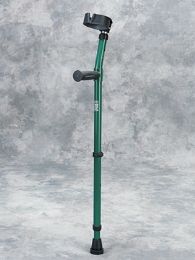.jpg&newheight=260&quality=80)


_a021.jpg&newheight=260&quality=80)










~7.jpg&newheight=260&quality=80)

What are crutches?
Crutches are a type of mobility device that aim to reduce the amount of weight you put on your legs when you walk, while helping to increase your balance and stability. They transfer weight from your legs to your upper body, and are often used for people who cannot use their legs to support their weight. Reasons range from short-term injuries, such as a sprain or a surgical procedure requiring you to keep your weight off a leg or foot, to lifelong disabilities, such as cerebral palsy. Crutches can enable you to get around on your own power so you can keep your independence. Steel or aluminum crutches are made from a single contoured tubular shaft, and you can adjust its height with push-button positioning.
What types of crutches are available?
Forearm crutches are a type of crutch with a cuff at the top that goes around your forearm, and are often used on a long-term basis. A forearm crutch is typically made from an aluminum tube shaft with a molded handgrip and a forearm cuff that extends to about 2 inches below the elbow. They are employed for use by inserting your arm into a cuff and holding the grip. They distribute your weight to your arms, allowing you more comfort and convenience.
The cuff, typically made of plastic or metal, can be a half-circle or a full circle with a V-type opening in the front allowing your forearm to slip out and to release your hand without the crutches falling. It gives you the support of a cane, but with additional forearm support to assist in mobility. The forearm portion helps you increase your balance, lateral stability and reduces the load on your wrist, and its ergonomic contour gives you better comfort and stability. The handgrip enables you to hold and rest your hand on it so you can help support your body weight.
Forearm crutches are made with different heights and weight capacities to ensure the perfect comfort and mobility for your specific requirements. Both the leg and forearm pieces can be adjusted independently in length, and their smaller size and lighter build make them more portable. They are well suited for applications that involve physical therapy and physical rehabilitation.
Platform crutches are used by those with poor hand grip strength due to arthritis, cerebral palsy or other conditions. Your arm rests on a horizontal platform and is strapped in place, and your hand rests on a grip which can be angled appropriately depending on your disability.
Bariatric forearm crutches are designed to support larger weight capacities while still maintaining a light, over-all handling weight.
Youth/child crutches are lightweight crutches designed for children who require ambulatory assistance.
How do I choose the best crutches?
When choosing crutches, keep in mind that having large tips at the base of each crutch adds security and stability. You should also ensure that the crutches you’re selecting have the weight bearing strength you need. Consider the total length of the crutch and the height of the handle to make sure it fits you comfortably.
Rehabmart is pleased to carry a large assortment of forearm crutches from well-known vendors including Drive Medical, Walk Easy Inc., TFI Healthcare, Stander Inc., Medline, Danmar, Carex and ErgoActives.
Hulet Smith, OT
Rehabmart Co-Founder & CEO
lb